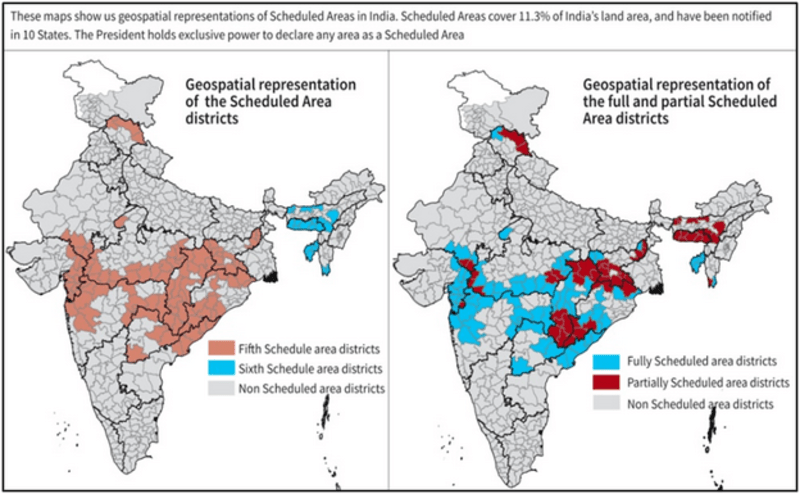Context
Despite the persistent and pressing demands made by Adivasi organizations, the exclusion of villages in the 10 States with Scheduled Areas and in other States with ST populations remains a matter of grave concern.
Scheduled Areas and Constitutional Provisions in India
Scheduled Tribe (ST) Communities
India is home to 705 Scheduled Tribe (ST) communities, constituting 8.6% of the country's population. These communities reside across 26 States and six Union Territories.
Scheduled Areas:
Scheduled Areas, encompassing 11.3% of India's total land area, have been officially designated in 10 States, which include Andhra Pradesh, Telangana, Odisha, Jharkhand, Chhattisgarh, Madhya Pradesh, Rajasthan, Gujarat, Maharashtra, and Himachal Pradesh.
Constitutional Relevance Article 244:
Within the context of Scheduled and Tribal Areas administration, Article 244 holds paramount importance in India's constitutional framework.
- Article 244(1): This clause allows for the application of Fifth Schedule provisions to Scheduled Areas notified in any State other than Assam, Meghalaya, Tripura, and Mizoram.
- Article 244(2): In these States (Assam, Meghalaya, Tripura, and Mizoram), the Sixth Schedule provisions take precedence.
To clarify, the Fifth Schedule, as defined under Article 244(1) of the Constitution, delineates the parameters of Scheduled Areas, while the Sixth Schedule, specified in Article 244(2) of the Constitution, provides definition and guidance for Tribal Areas.

Governance of Scheduled Areas
Notification of Scheduled Areas: The President of India is responsible for designating India's Scheduled Areas. The courts have emphasized that this declaration lies within the exclusive discretion of the President.
Tribal Advisory Council: States with Scheduled Areas are mandated to establish a Tribal Advisory Council comprising up to 20 Scheduled Tribe (ST) members. This council advises the Governor on matters related to ST welfare, and the Governor submits an annual report to the President regarding the administration of Scheduled Areas.
Role of Central Government: The central government can provide directions to the State regarding the administration of Scheduled Areas.
Role of Governor: The Governor holds the authority to amend or repeal any law passed by Parliament and the State Legislative Assembly within the application of the Scheduled Area. Furthermore, the Governor can create regulations for Scheduled Areas, especially pertaining to the prohibition or regulation of the transfer of tribal land among ST members, as well as the allocation of land and money lending to STs.
Identification of Scheduled Areas: Although the Constitution and existing laws do not provide specific criteria for identifying Scheduled Areas, the 1961 Dhebar Commission Report serves as a guiding reference. The key norms for declaring an area as a Scheduled Area include the predominance of tribal population, reasonable area size and compactness, a feasible administrative entity (e.g., district, block, or taluk), and economic backwardness relative to neighboring areas.
Issues & Challenges
- Exclusion of Areas: Delays in the Indian government's approval of State government proposals have resulted in the exclusion of villages from the purview of Scheduled Areas in 10 States, despite persistent demands from Adivasi organizations. This exclusion means that 59% of India's STs are denied rights under the applicable laws of Scheduled Areas, including the Right to Fair Compensation and Transparency in Land Acquisition, Rehabilitation, and Resettlement Act 2013, and the Biological Diversity Act 2002.
- Demands for Denotification: There have been calls for the denotification of parts of Scheduled Areas where STs have become a minority due to the influx of nontribal individuals. The extensive provisions and authority vested in Governors, under the oversight of the President, have remained largely unutilized.
- Non-Inclusion of Areas: The 2002 Scheduled Areas and Scheduled Tribes Commission recommended that all revenue villages with 40% or more tribal population according to the 1951 Census be considered as Scheduled Areas. However, the Ministry of Tribal Affairs communicated this to the States in 2018 with no response.
|
Enactment of PESA (Panchayats Extension to Scheduled Areas) Act The realization of the intent behind the Constitution and the Constituent Assembly's vision for Scheduled Areas became a reality with the enactment of the Panchayats (Extension to Scheduled Areas) Act, or PESA, in 1996. This legislation played a pivotal role in fulfilling the constitutional goals in Scheduled Areas. Need for the Act:
Empowerment of Gram Sabhas:
Definition of 'Village' & 'Gram Sabha:
|
Suggestions & the Way Forward
All habitations or groups of habitations outside Scheduled Areas in all States and Union Territories where STs form the largest social group should be notified as Scheduled Areas, regardless of their contiguity.
Compactness should be prioritized, meaning that proposed villages should be contiguous with each other or with an existing Scheduled Area. Contiguity, while essential, should not be the sole demarcating criterion.
Geographical limits of these villages should be extended to include the 'community forest resource' areas on forest land under the FRA 2006 where applicable and the customary boundaries within revenue lands through suitable amendments to relevant State laws.
The geographical limits of revenue villages, panchayats, talukas, and districts should be redrawn to ensure they are fully integrated as Scheduled Areas.



